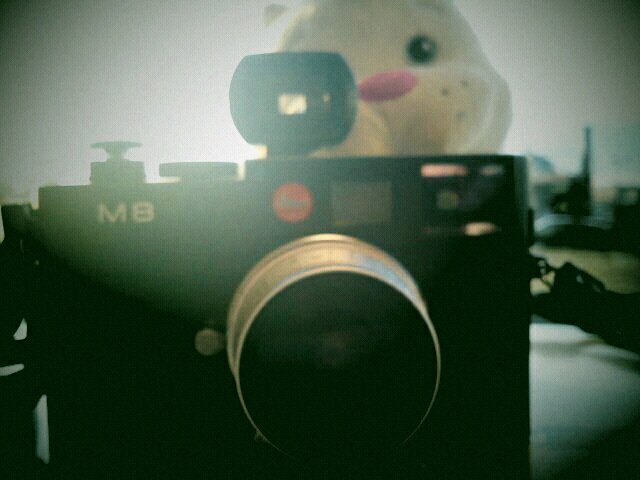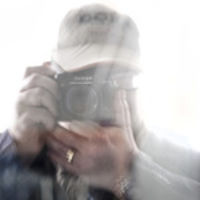Camera Obscura
Breaking News! Ricoh GXR med A12 modulen med Leica M-bajonett - bilder och specifikationer!
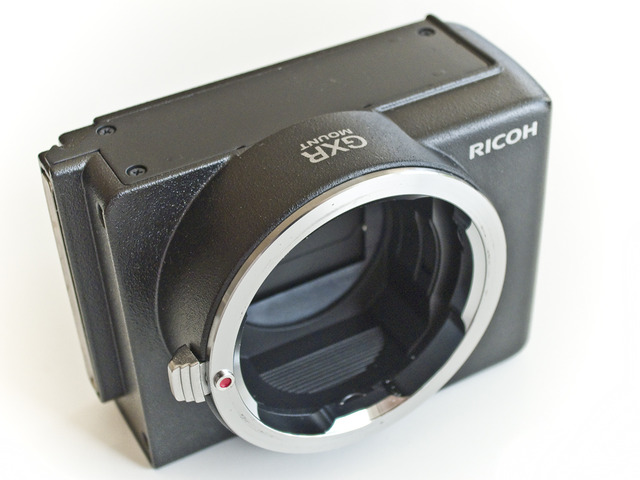
Ricoh GXR Kamera-modul A12 med APS-C CMOS-sensor, slutare och Leica M-bajonett.
Idag släpper Ricoh de fulla specarna för sin nya modul till GXR-systemet med Leica M-bajonett, pressreleasen finns återgiven längre ner i bloggposten. Jag har fått förmånen att få låna ett "för produktions" exemplar av modulen, bilden ovan. Denna är inte till 100% övernsstämmande med de serieproducerade modulerna som släpps i september men är trots det utmärkt för att bilda sig en uppfattning om handhavande och inte minst bildkvalitet. Från vänster: Panasonic GF1 + 35/1,2 med adapter, Ricoh GXR + A12 med 25/4, Leica M8 + 35/2.
Från vänster: Panasonic GF1 + 35/1,2 med adapter, Ricoh GXR + A12 med 25/4, Leica M8 + 35/2.
Nu finns det förutom Leica M8/M9 yterligare ett alternativ för den som vill använda objektiv med M-bajonett (från Leica, Zeiss, Voigtländer mfl) vid sidan av Micro Fourthirds (Panasonic och Olympus), Sony Nex och gamla Epson RD1. Några av fördelarna med Ricohs A12 modul är att den har APS-C sensor och M-bajonett, dvs mindre sk "brännviddsförlängning" än med Micro 4/3 och ingen adapter behövs.
Läs hela pressreleasen (på engelska) nedan:
---
August 5, 2011
Ricoh announces GXR MOUNT A12
A GXR lens mount unit featuring an APS-C size CMOS sensor
Tokyo, Japan, August 5, 2011—Ricoh Co., Ltd. (president and CEO: Shiro Kondo) today announced the development and planned September 9, 2011 release of the new product GXR MOUNT A12, a lens mount unit exclusively for the GXR interchangeable unit camera system. The body color will be black only, and the planned monthly production volume is 3,000 units.
Introduced in December 2009, the GXR is a revolutionary interchangeable unit camera system in which lenses can be changed by mounting camera units that integrate lens, image sensor, and image processing engine into a single unit. In addition, utilizing its unique ability to accommodate interchangeable units other than camera units, the system can be expanded to include a variety of other devices.
The new GXR MOUNT A12 is a lens mount unit made especially for the GXR. Featuring an APS-C size CMOS sensor and a newly developed focal plane shutter, this unit makes it possible to mount lenses such as Leica M lenses, and it provides various types of compensation and correction functions.
<Main features of GXR MOUNT A12>
1. The newly adopted APS-C size CMOS sensor expands possibilities for high resolution and imaging power.
・The adoption of a CMOS sensor with an optimized micro lens layout makes it possible to secure sufficient brightness levels even in the peripheral areas of the image.
・The CMOS sensor used is 23.6mm × 15.7mm (APS-C size). It enables the shooting of high-quality images with smooth tone gradations as well as high definition and low noise.
2.Compatibility with a wide variety of lenses, including Leica M mount lenses.
・Compatible with the Leica M mount, GXR MOUNT A12 can, of course, handle M-mount lenses, and if a conversion adapter is used many more types of mounts can also be accommodated.
・A checking device is included for use in confirming whether or not your lenses are physically compatible.
3.Diverse new functions maximize the potential of the lens itself
・In order to accommodate the photographer’s own preferences by adjusting for the distinctive characteristics of many different lenses, GXR MOUNT A12 can independently correct coloring at the corners. Color shading correction is possible in a -4 to +4 range for both R and B.
・Peripheral illumination correction is possible in a -3 to +3 range.
・A distortion correction function is provided to correct for the distortion that tends to occur in the lens periphery. The photographer can select barrel and pincushion distortion and specify “strong,” “medium,” or “weak” for each.
・A glass optical filter was adopted and made as thin as possible. It increases periphery image quality and suppresses field curvature.
4.High-precision focusing
・A focus-assist function has been included in an effort to raise the accuracy of manual focusing. The photographer can select from two modes and check the focus by strengthening outlines and contrast.
・Magnifying the screen image while shooting is an effective technique for focusing. The magnification can be done not only in the center but throughout the image. In addition, the image quality for 4x and 8x magnification has been further enhanced. The area to be magnified can be moved using the directional pad.
5.Two shutter methods are featured: newly developed focal plane shutter and electronic shutter
・With the focal plane shutter, settings of 1/4000 sec. to 180 sec. are possible.
・With the electronic shutter, settings of 1/8000 sec. to 1 sec. are possible, and the photographer can shoot without worrying about shutter noise and vibration.
6.The wide range of functionality that characterizes the GXR series
・My Settings enables a wide range of shooting functions to be specified in an instant. For the setting information storage, six patterns can now be stored in the body’s My Settings Box and six patterns can be stored in the SD card. This, along with the ability to change shooting conditions, further expands the photographer’s world of photo expression.
・In manual exposure mode, the shutter speeds B (bulb) and T (time) can be selected. With B, the exposure continues while the shutter release button is pressed, and with T, the shutter release button is pressed to start and end the exposure. For both B and T, the exposure is automatically ended when 180 seconds have elapsed.
・Information on the lens used can be put in the EXIF information. In the editing of My Settings information, lens name, focal length, and F value can be entered.
・New scene mode options have been added for the easy enjoyment of a wide range of photo expression. The five new options are soft focus, cross process, toy camera, miniaturize, and high contrast B&W. The photographer can create a unique image by just pressing the shutter release button.
・An electronic level utilizing an acceleration sensor.
・An image flag function to enable the quick display of specific images from among those in the camera. Up to 20 images can be flagged.
・For the exterior, we utilized die cast magnesium, which has a strong track record in the GR series, and we covered the surface with a corrosion-resistant "pear-skin" coating. The end result is a body with durability, light weight, and a superior feel in hand.
・It is possible to shoot 1280 × 720 pixel HD movies.
* Note: When shooting movies of 1280×720 size, the use of an SD/SDHC memory card with an SD speed class of Class 6 or higher is recommended.
7.New options added
・ We have created the new soft cases SC-75B and SC-75T, which are easy to open and close. With SC-75B, it is possible to shoot with the case attached to the GXR body.
<GR MOUNT A12 options>
Product Model
Soft Case B (lower portion and strap) SC-75B
Soft Case T (upper portion only) SC-75T
*All of the focal lengths in this release are converted to the equivalent values for a 35 mm film camera.
*SC-75T cannot be used as a case by itself. It must be used together with SC-75B.
*SC-75B and SC-75T are new options being introduced at this time.
*Functions when the GXR body is attached
<GXR MOUNT A12 Major Specifications>
Effective pixels:
Approximately 12.30 million
Image sensor:
23.6 mm × 15.7 mm CMOS sensor (total pixels: approx. 12.90 million pixels)
Zoom:
Digital zoom: 4.0x (3.6x for movies)
Auto resize zoom: Approx. 5.9x (VGA)
Focus Mode:
Manual focus
Shutter speed:
Photographs: 1/4000 - 180 s, bulb, time (upper and lower limits vary according to shooting and flash modes)
Maximum flash sync shutter speed: 1/180 s
Movies: 1/2000 - 1/30 s
Exposure control:
Metering: TTL metering in multi (256-segment), center-weighted, and spot metering (TTL metering with auto exposure lock)
Mode: Aperture priority AE, manual exposure
Exposure compensation: Manual (+4.0 to -4.0 EV in increments of 1/3 EV or 1/2 EV), auto bracketing (-2 EV to +2 EV in increments of 1/3 EV or 1/2 EV)
Exposure range (auto mode, center-weighted metering):
Using standard lens (F2.5): 1.2 EV to 13.2 EV
(Exposure range for auto ISO calculated using values for ISO 100.)
ISO sensitivity (standard output sensitivity):
Auto, Auto-Hi, ISO-Lo, ISO 200, ISO 250, ISO 320, ISO 400, ISO 500, ISO 640, ISO 800, ISO 1000, ISO 1250, ISO 1600, ISO 2000, ISO 2500, ISO 3200
White balance:
Auto / Multi-P AUTO / Outdoors / Cloudy / Incandescent Lamp 1 / Incandescent Lamp 2 / Fluorescent Lamp / Manual Settings / Detail; white balance bracketing
Flash:
Method: TTL, manual, external auto (external flash GF-1 function)
Flash mode: Auto, Anti Red-eye, Flash On, Flash Synchro, Manual, Flash Off
Guide number: 9.6 (ISO 200 equivalent), 6.8 (ISO 100 equivalent)
Illumination angle: 24 mm (35 mm film camera equivalent)
Firing timing: 1st/2nd curtain sync
Other: External flash GF-1 compatibility
Shooting mode:
Auto / Program Shift / Aperture Priority / Shutter Priority / Manual / Scene (Movie, Portrait, Sports, Landscape, Nightscape, Skew Correction, Miniaturize, High Contrast B&W, Soft Focus, Cross Process, Toy Camera, Electronic Shutter) / My Settings
Continuous mode:
Number of pictures shot in Continuous (Picture Size: RAW):
Noise Reduction on weak or off: 4 pictures
Noise Reduction on strong: 3 pictures
Noise Reduction on MAX: 3 pictures
Number of pictures shot in M-Cont Plus (1 set):
HI (1280 × 856): 30 pictures (24 frames/sec.)
LO (4288 × 2848): 15 pictures (2.2 frames/sec.)
Compression ratio *1:
FINE, NORMAL, RAW (DNG) *2
Image size (pixels):
Photographs:
16:9 4288×2416, 3456×1944
4:3 3776×2832, 3072×2304, 2592×1944, 2048×1536, 1280×960, 640×480
3:2 4288×2848, 3456×2304
1:1 2848×2848, 2304×2304
Movies:
1280×720, 640×480, 320×240
File size (approx.):
RAW:
16:9
4:3
3:2
1:1
L:
16:9 NORMAL: 2,222 KB/frame, FINE: 3,816 KB/frame
4:3 NORMAL: 2,315 KB/frame, FINE: 3,960 KB/frame
3:2 NORMAL: 2,615 KB/frame, FINE: 4,493 KB/frame
1:1 NORMAL: 1,761 KB/frame, FINE: 3,009 KB/frame
M:
16:9 NORMAL: 1,475 KB/frame, FINE: 2,509 KB/frame
4:3 NORMAL: 1,574 KB/frame, FINE: 2,662 KB/frame
3:2 NORMAL: 1,744 KB/frame, FINE: 2,968 KB/frame
1:1 NORMAL: 1,186 KB/frame, FINE: 2,003 KB/frame
5M:
4:3 FINE: 2,287 KB/frame
3M:
4:3 FINE: 1,474 KB/frame
1M:
4:3 FINE: 812 KB/frame
VGA:
4:3 FINE: 197 KB/frame
Based on CIPA standard DB-90: approx. 330 shots*3
Dimensions (W × H × D):
Lens mount unit only: 79.1 mm × 60.9 mm × 40.5 mm
(according to CIPA guidelines)
When mounted on the GXR body: 120.0 mm × 70.2 mm × 45.7 mm
(according to CIPA guidelines)
Flange back: 27.8 mm
Weight (approx.):
Lens mount unit only: Approx. 170 g
When mounted on camera body: Approx. 370 g (battery and SD memory card included)
Operating temperature:
0 °C to 40 °C
Operating humidity:
90% or less
Storage temperature:
–20 °C to 60 °C
*1 The compression ratios which can be set vary depending on the image size.
*2 A JPEG file is also recorded (the JPEG file may be a FINE- or NORMAL-quality file with the same dimensions as the RAW file or a VGA file 640 × 480 pixels in size). RAW files use the standard DNG format promoted by Adobe Systems Incorporated.
*3 For reference only; actual number of shots varies greatly according to how camera is used. We recommend that you carry spare batteries when in use for extended periods.
(GXR
---
Ricoh A12 GXR Mount - dvs Leica M-bajonett.
För er som undrar - slutaren är öppen när man använder skärmsökaren och används bara i själva exponeringsögonblicket. Mer om funktion och bildkvalitet i kommande bloggposter.
Nu ska jag ut och fotografera ;-)
Ps.
Om du vill läsa mer omedelbart så ligger det en "Hands-on Preview" på Dpreview.com :-)
Sommar, sol, tomma stränder, Leica, slow photography och... hamstrar!

Panasonic Lumix GF1 + 40/1,7 "Den Rosa Hamstern" i S/V, beskuren och rejält manipulerad i Photoshop ;-)
Nu när semestern slagit till på allvar så avstannar även bloggandet - men inte fotograferandet. Fast det tar sig en annan form, blir långsammare och liksom prestationsbefriat. Mera lek och mindre allvar. Och lite mera bus i PhotoShop - i alla fall ibland, som ovan ;-)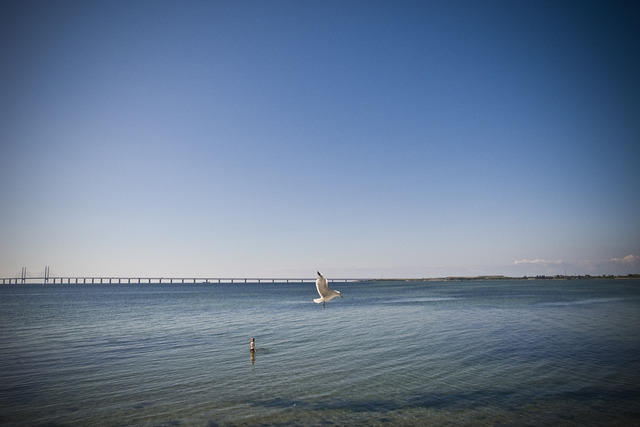
Ricoh GR-D III Konverterad från RAW i Photoshop och obeskuren. Klagshamn.
Men också mera "snaps" och färre uppsökta, uttänkta motiv. Lite mera "DOGMA" skulle man kunna säga...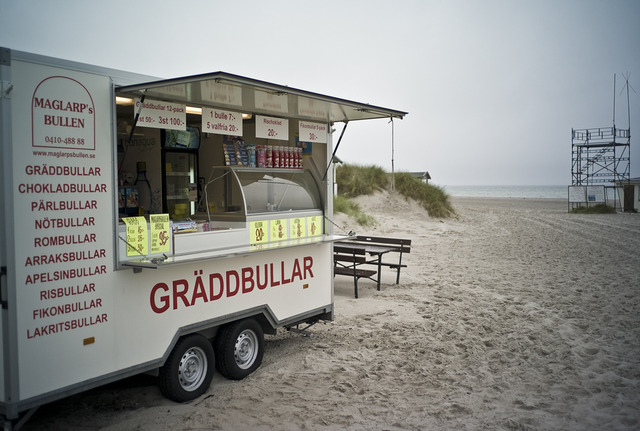
Leica M8 + CV 28/2 Konverterad från RAW i Photoshop och såklart obeskuren. Skanör.
Kameran får helt enkelt bara följa med, oftast bara Ricoh GR-D III:an, som liten och lätt gömd strandkamera. (Vem vågar lämna en Leica M8 med glugg bland kläderna när man badar?) Ibland Panasonic Lumix GF1:an - om det krävs lite högre ISO-tal, och så Leican - när omständigheterna så medger.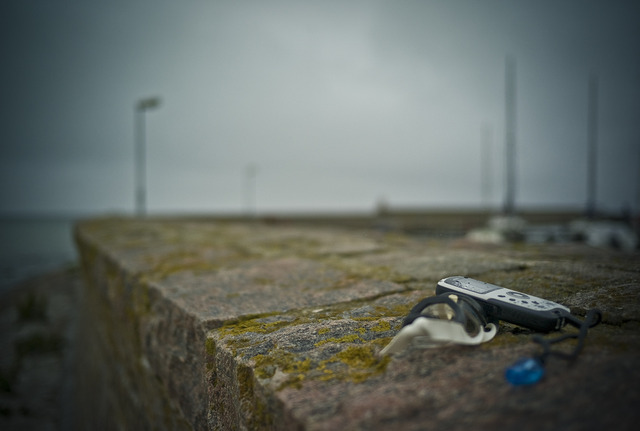
Leica M8 + CV 28/2 Föreställande mina simglasögon och dotterns Kodak på piren i Skanörs hamn :-)
Och alltid dotterns lilla Kodak (bilden ovan) som är vattentät ner till 3m därmed tål både sand och saltvatten. Liten, enkel och grymt rolig - för hela familjen. Men mer om bilder tagna med den - både över och under vattenytan i ett kommande inlägg.
Uppdaterat Lecia M8:ans firmware till 2.014 - men hallå Leica - hur tänker ni?

Leica har släppt en uppdatering av den interna mjukvaran (firmware) till Leica M8 och M8.2 - här är länken.
Vad gör nu den nya mjukvaran? Bla så finns 6-bit koden för nya 21/3,4 med och så "förbättras de interna processerna" - vad det nu kan tänkas innebära? 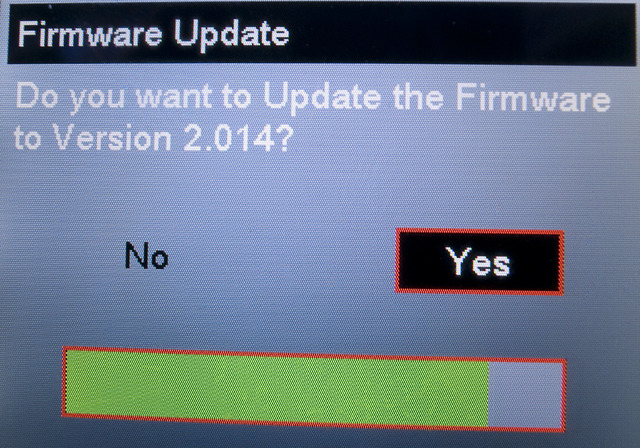
En märkbar förbättring är att den suddiga "förhandsbilden" i visningsläget är borta - bilden uppträder skarp på en gång - tack Leica.
Rapporter om bättre brusreducering förekommer - jag har inte hunnit testa själv...
Men jag saknar verkligen en funktion, som finns på M9:an, och borde vara enkel att lägga till även på M8:an - möjligheten att manuellt ställa in vilket objektiv som används. Nu måste jag även i fortsättningen antingen använda kodade objektiv eller välja "okodat objektiv + IR-filter" i menyn.
Snällla, snälla Leica - ge även oss M8 fotografer möjligheten att manuellt ställa in rätt objektiv (med eller utan IR-filter) i menyn!
Fördelarna med EVIL - de raka linjernas tyranni
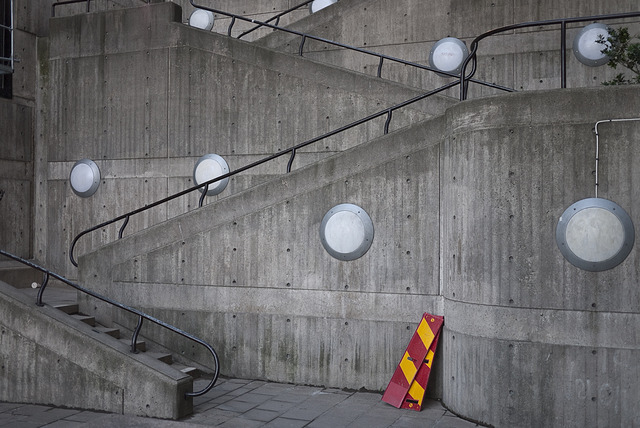
Panasonic Lumix GF1 + 40/1,7 Konverterad från RAW i Photoshop och såklart obeskuren.
Hur känslomässigt bunden jag än är till Leicas mätsökare - så måste jag erkänna att systemet har sina givna brister. Den klassiska mätsökaren (som idag bara finns hos Leica, Zeiss Ikon, Voigtländer och Fujifilm) lämpar sig bäst för reportage och/eller sk gatufotografi.
När det kommer till exakta kompositioner där utsnittet behöver kontrolleras i detalj så kommer de till korta. Då de generellt visar lite för lite av den verkliga bilden (dvs du får med mer än du räknat med) så kan man ju alltid beskära bilden i efterhand. men jag och antagligen många med mig vill gärna komponera bilden exakt i sökaren och sedan helst undvika all beskärning.
Då är den elektroniska sökaren oslagbar och den sk EVIL (Electronic Viewfinder Interchangeable Lenses) kameran ett perfekt verktyg. "Live view" på en DSLR ger ju samma resultat men med ett mycket större och tyngre verktyg.
I och med Fujifilm X100 så har man plötsligt kombinerat det bästa av två världar, men kamerans avsaknad av utbytbart objektiv (dvs den är inte EVIL) begränsar dess potential rejält.
Så min stilla önskan är att nästa Leica (M10?) får åtminstone "Live view" men ännu hellre en hybridsökare a la Fujifilm X100. Vågar man hoppas?
White hamster blues - eller vem vill ge över 150.000 Kr för en kamera med normal?
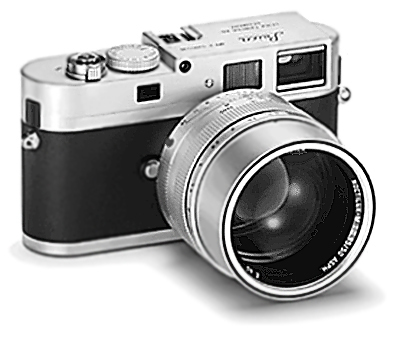
En fotoaffär i Österrike har beställst 20 st helt egna Leica M9-P med tillhörande Noctilux 50mm f0,95 - allt i skinande krom. Så om du tycker att den "vanliga" Noctiluxen i svart och med en prislapp på 81.000 Kr inte imponerar nog mycket på dina fotokompisar - nu kan du få ge betydligt mer för en kromad och i princip få en M9-P på köpet ;-)
Som balans till denna extrema "lyxifiering" av fotografin så gick jag med den Vita Hamstern och såg på Moderna museets fotoutställning. Många av bilderna där var faktiskt tagna med Leica, men av fotografer som med största säkerhet betraktade Leica som just en kamera och använde den som en sådan...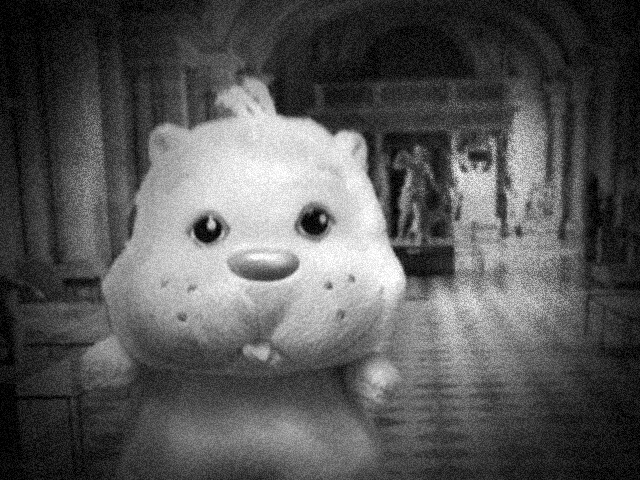
Om du till äventyrs tröttnar på att läsa om orealistiskt dyra kameror i min blogg så kan du alltid följa den Rosa och den Vita Hamsterns äventyr på Facebook ;-)
Detta måste dock tilläggas - den Vita Hamstern har absolut inget emot Leica!